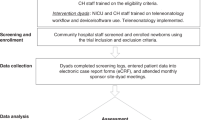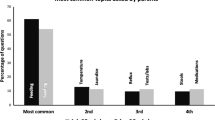Abstract
Background
Many infants in the neonatal intensive care unit (NICU) have genetic disorders or birth defects. The demand for genetic services is often complicated by a shortage of genetic providers.
Problem
Our hospital experienced a significant reduction in genetic workforce, leading to insufficient genetic services to meet demand.
Methods
The Plan-Do-Study-Act method of quality improvement was used to assess available resources, select an intervention plan, and collect patient outcome and provider satisfaction data.
Intervention
An asynchronous telehealth model was deployed for clinical genetics consultations in our NICU utilizing a remote clinical geneticist.
Results
The pilot study included 111 asynchronous telehealth consultations; 21% received a genetic diagnosis before discharge. Diagnoses were primarily chromosomal and single gene disorders. Referring NICU providers reported high satisfaction.
Conclusion
Asynchronous telehealth for clinical genetics is a feasible and successful alternative to an on-site clinical geneticist and should be considered in areas with a genetic workforce shortage.
This is a preview of subscription content, access via your institution
Access options
Subscribe to this journal
Receive 12 print issues and online access
$259.00 per year
only $21.58 per issue
Buy this article
- Purchase on Springer Link
- Instant access to full article PDF
Prices may be subject to local taxes which are calculated during checkout



Similar content being viewed by others
References
Genetic services: information on genetic counselor and medical geneticist workforces [Internet]. Washington, DC: U.S. Government Accountability Office; 2020 Jul [cited 2021 Mar 5]. Report No.: GAO-20-593. Available from: https://www.gao.gov/assets/710/708545.pdf.
Find a certified genetic counselor [Internet]. American Board of Genetic Counseling. 2020 [cited 2020 Jun 30]. Available from: https://www.abgc.net/about-genetic-counseling/find-a-certified-counselor/.
Nguengang Wakap S, Lambert DM, Olry A, Rodwell C, Gueydan C, Lanneau V. et al. Estimating cumulative point prevalence of rare diseases: analysis of the Orphanet database. Eur J Hum Genet. 2020;28:165–73.
Kubendran S, Sivamurthy S, Schaefer GB. A novel approach in pediatric telegenetic services: geneticist, pediatrician and genetic counselor team. Genet Med. 2017;19:1260–7.
Stoll K, Kubendran S, Cohen SA. The past, present and future of service delivery in genetic counseling: Keeping up in the era of precision medicine. Am J Med Genet C Semin Med Genet. 2018;178:24–37.
Mississippi state department of health public health regions [Internet]. Mississippi State Department of Health. [cited 2020 Jun 30]. Available from: https://msdh.ms.gov/msdhsite/_static/resources/7322.pdf.
Maiese DR, Keehn A, Lyon M, Flannery D, Watson M.Working Groups of the National Coordinating Center for Seven Regional Genetics Service Collaboratives Current conditions in medical genetics practice. Genet Med. 2019;21:1874–7.
Lalani SR. Current genetic testing tools in neonatal medicine. Pediatr Neonatol. 2017;58:111–21.
Synnes AR, Berry M, Jones H, Pendray M, Stewart S, Lee SK. et al. Infants with congenital anomalies admitted to neonatal intensive care units. Am J Perinatol. 2004;21:199–207.
Willig LK, Petrikin JE, Smith LD, Saunders CJ, Thiffault I, Miller NA. et al. Whole-genome sequencing for identification of Mendelian disorders in critically ill infants: a retrospective analysis of diagnostic and clinical findings. Lancet Respir Med. 2015;3:377–87.
Wenger TL, Gerdes J, Taub K, Swarr DT, Deardorff MA, Abend NS. Telemedicine for genetic and neurologic evaluation in the neonatal intensive care unit. J Perinatol J Calif Perinat Assoc. 2014;34:234–40.
Malandraki GA, Markaki V, Georgopoulos VC, Bauer JL, Kalogeropoulos I, Nanas S. An international pilot study of asynchronous teleconsultation for oropharyngeal dysphagia. J Telemed Telecare. 2013;19:75–9.
Rouse CA, Woods BT, Mahnke CB. A retrospective analysis of a pediatric tele-echocardiography service to treat, triage, and reduce trans-Pacific transport. J Telemed Telecare. 2018;24:224–9.
Health resources and services administration. Telehealth Center of Excellence - UMMC [Internet]. Health Resources and Services Administration. [cited 2020 Aug 31]. Available from: https://www.hrsa.gov/library/telehealth-coe-ummc.
Borghesi A, Mencarelli MA, Memo L, Ferrero GB, Bartuli A, Genuardi M. et al. Intersociety policy statement on the use of whole-exome sequencing in the critically ill newborn infant. Ital J Pediatr. 2017;43:100.
Yang Y, Muzny DM, Xia F, Niu Z, Person R, Ding Y. et al. Molecular findings among patients referred for clinical whole-exome sequencing. JAMA . 2014;312:1870–9.
Campbell J, Theodoros D, Russell T, Gillespie N, Hartley N. Client, provider and community referrer perceptions of telehealth for the delivery of rural paediatric allied health services. Aust J Rural Health. 2019;27:419–26.
Kim EW, Teague-Ross TJ, Greenfield WW, Keith Williams D, Kuo D, Hall RW. Telemedicine collaboration improves perinatal regionalization and lowers statewide infant mortality. J Perinatol. 2013;33:725–30.
Lorch SA, Myers S, Carr B. The regionalization of pediatric health care. Pediatrics. 2010;126:1182–90.
Acknowledgements
The authors acknowledge Bethany Robinette, FNP and her efforts in the role of genetic NP.
Funding
The University of Mississippi Medical Center provided financial support for the hiring of the remote clinical geneticist.
Author information
Authors and Affiliations
Contributions
EB: conceptualization, data curation, formal analysis, investigation, methodology, project administration, writing-original draft, writing-review, and editing. BW: data curation, formal analysis, investigation, methodology, writing-original draft, writing-review, and editing. LH: conceptualization, methodology, writing-original draft, writing-review, and editing. JK: conceptualization, methodology, writing-original draft, writing-review, and editing. BK: conceptualization, data curation, formal analysis, investigation, methodology, project administration, resources, supervision, writing-original draft, writing-review, and editing.
Corresponding author
Ethics declarations
Conflict of interest
The authors declare no competing interests.
Additional information
Publisher’s note Springer Nature remains neutral with regard to jurisdictional claims in published maps and institutional affiliations.
Rights and permissions
About this article
Cite this article
Boothe, E., West, B., Hendon, L.G. et al. Asynchronous telemedicine for clinical genetics consultations in the NICU: a single center’s solution. J Perinatol 42, 262–268 (2022). https://doi.org/10.1038/s41372-021-01070-1
Received:
Revised:
Accepted:
Published:
Issue Date:
DOI: https://doi.org/10.1038/s41372-021-01070-1



